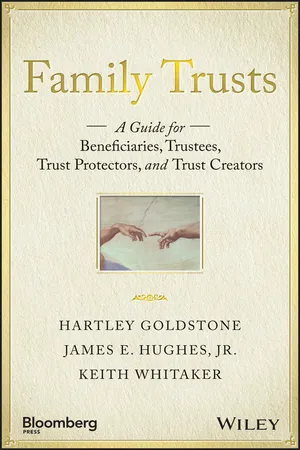
Family Trusts
A Guide for Beneficiaries, Trustees, Trust Protectors, and Trust Creators
- English
- ePUB (mobile friendly)
- Available on iOS & Android
Family Trusts
A Guide for Beneficiaries, Trustees, Trust Protectors, and Trust Creators
About this book
An insightful and practical guide to family trusts
Family Trusts is a step-by-step guide for anyone involved in family trusts: trust creators, trustees, beneficiaries, and advisors. It will help families create and administer a culture that recognizes trusts as a gift of love.
Marrying the practical and emotional aspects of family wealth, this book provides a hands-on primer that focuses on fostering positive relationships, and structuring the trust appropriately for the situation and the people involved. It tackles difficult topics with frank and honest discussion, from the first beneficiary meeting to working with addictions, and more. Written by a team of experts in family wealth, this information is becoming increasingly crucial to the successful execution of a trust; you'll learn what type of person makes the best trustee, how to be an excellent beneficiary, and the technical aspects that help you build a better trust from the very beginning.
There's been a staggering increase in trustee/beneficiary litigation and hostility, but that doesn't mean it's inevitable. Plenty of trusts are running smoothly, with positive experiences on all sides. This book shows you how to set up your trust to succeed from the start, with step-by-step guidance and expert insight.
- Express clear and thoughtful intent for the trust
- Create a healthy and supportive culture
- Select the right trustee, trust protector, and trust advisor
- Take the time to prepare before initially meeting the beneficiary
- Conduct a productive first meeting to set a tone for the relationship
Historically, there has been little consideration given to the culture of trusts, and this oversight may be a key driver of the behavior that's becoming more prevalent. Family Trusts explores the nature of these relationships, and shows you how to build a trust that retains the nature and spirit with which it was intended.
Frequently asked questions
- Essential is ideal for learners and professionals who enjoy exploring a wide range of subjects. Access the Essential Library with 800,000+ trusted titles and best-sellers across business, personal growth, and the humanities. Includes unlimited reading time and Standard Read Aloud voice.
- Complete: Perfect for advanced learners and researchers needing full, unrestricted access. Unlock 1.4M+ books across hundreds of subjects, including academic and specialized titles. The Complete Plan also includes advanced features like Premium Read Aloud and Research Assistant.
Please note we cannot support devices running on iOS 13 and Android 7 or earlier. Learn more about using the app.
Information
Part One
Introducing the Trustscape
Chapter 1
Navigation Works Better When You Have a Destination in Mind
- This type of relationship is altogether new to you. Although I've been a trustee for many other beneficiaries, our relationship is new and unique to me, as well. So what do you think are some solid steps for us to take toward becoming colleagues in a reciprocal relationship? If I am to mentor you, how would you like to be mentored?
- How can our relationship generate positive energy for each of us, rather than take energy away or make either or both of us feel like we're “mired in quicksand”?
- How can our relationship help to bring your aspirations to life? Aspirations for your family or community, and especially for your individual growth?
- What have I (the beneficiary) contributed to our falling out?
- What's a step—no matter how small—I might take toward getting us back into “right” relationship?
- Who do I know who might help me think this situation through?
Beyond the Thought Experiment
- 1931: Many trusts were created in anticipation of 1932, when the top estate tax rate jumped from 20 percent to 45 percent and the estate tax exemption dropped from $100,000 to $50,000.
- 1933: Trusts created in anticipation of 1934, when the maximum estate tax rate increased to 60 percent.
- 1934: Another vintage year in anticipation of the maximum estate tax rate increasing to 70 percent and estate tax exemption decreasing to $40,000.
Questions for Reflection
- What do you think are some valid reasons—the purpose and, to some extent, the destination—that should drive creation of a trust?
- What do you think should be the highest duties of the trustee and beneficiary?
- What other duties would you see as either complementary or even superior to these in your particular case?
Note
Chapter 2
The Trustscape
Table of contents
- Cover
- Additional Praise for Family Trusts
- Title Page
- Copyright
- Dedication
- Acknowledgments
- Foreword
- Preface
- Introduction
- Part One: Introducing the Trustscape
- Part Two: The Players
- Part Three: Building Great Relationships
- Part Four: A Comprehensive Model for a Humane Trustscape
- Appendices
- About the Authors
- Index
- End User License Agreement